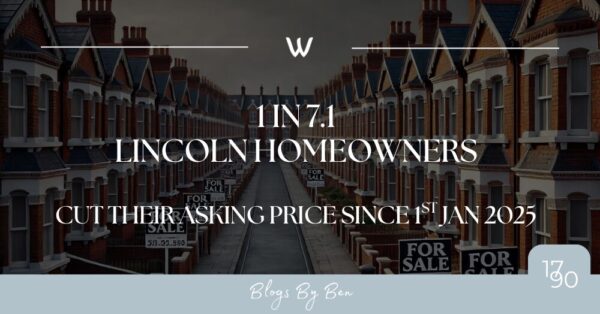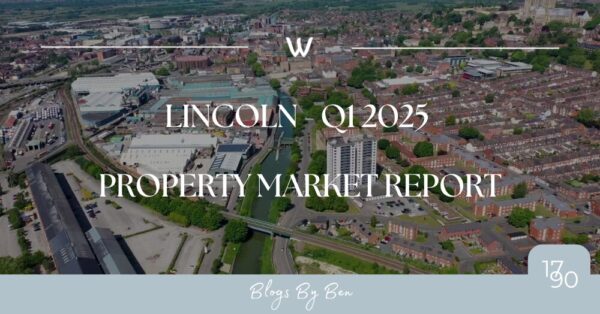The Lincoln housing market over the last three months is now becoming more ‘normal’ after the last couple of years of insane demand when the lockdowns started a race for space!
Even with the blackening economic doom-mongers forecasting a harsh slowdown in the British property market, the number of people buying and selling their homes is still exceptionally good for the time of year.
Whilst many homeowners are reducing their asking prices, it is not the 20% (some even said 30%) drop some property commentators and newspaper journalists had predicted.
Looking at the stats for Lincoln for the last three months since the disastrous Truss mini budget – they make good reading.
Of the 311 Lincoln properties that have sold (stc) since late September, the average length of time it took to achieve a sale was 59 days.
Interesting when you split it down by price, in Lincoln:
- Under £100k – 89 days
- £100k to £200k – 48 days
- £200k to £300k – 78 days
- £300k to £400k – 75 days
- £400k to £500k – 57 days
- £500k to £1m – 132 days
- £1m and above – no properties sold in this price range
And by type:
- Lincoln Apartment/Flat – 57 days
- Lincoln Terraced/Townhouse – 57 days
- Lincoln Semi-Detached – 50 days
- Lincoln Detached – 75 days
The latest sold price data from the Land Registry shows that Lincoln house prices currently remain 8.1% higher than they were 12 months ago; the rate of growth has dropped significantly.
Last month, Lincoln house prices only rose by 1.4%; thus, we are seeing the first sign that the property market is starting to cool.
With interest rates at 3.5% and further increases likely in 2023, that will undoubtedly spur ongoing cooling in Lincoln property values yet it’s doubtful we will see the Lincoln property market go into the deep freeze that many doom-mongers were predicting.
As I said in recent articles on the Lincoln property market, we will see a 5% to 10% reduction in Lincoln house prices over the next 12 to 18 months.
That will only take us back to the prices achieved in mid/late 2021 or early 2022 (depending on the property type).
Landlords have experienced double-digit rent growth in the last 12/18 months with a shortage of rental properties coming onto the market. I cannot see this changing in the short term, so I expect rents to be a further 10% higher by Christmas 2023.
Last week I stated it is not always wise to only focus on house prices but also take reference from the number of property transactions completed that feed the fire of the British property market.
For example, in March 2021, 135,670 properties sold, yet a month later, it dropped to 87,600. A couple of months later, it rose again in June 2021 to 165,290 homes sold (for it to drop to 64,000 in July).
Whilst this is good news for estate agents and removals companies, it can skew the property market and put undue pressure on the property market (pressure which could cause a housing crash if not put under check).
Like most things – slow, steady, and consistent is the preferred option for the property market. Throughout 2022, the number of properties selling in the UK has been a steady average of 68,832 per month, ranging from a low of 61,800 in January 2022 to 72,200 in July 2022.
This consistency will continue into 2023 and a return to a more ‘normal’ housing market.
One final thing I have noticed about the Lincoln property market in the last six months is the number of larger properties coming onto the market that last sold over 25 years ago.
Homeowners in their 20s, 30s and early 40s tend to move every five or six years, yet when they reach their late 40s and 50s, they tend to stay put for longer. These properties only tend to come on the market when people pass away or must be sold for nursing home fees.
These mature homeowners are downsizing for several reasons. Their children have flown the nest and they’re rattling around in homes with accommodation they don’t need. Many are being driven to sell their large homes considering mounting energy bills, high inflation, and never-ending maintenance costs that larger properties demand.
The second reason is that the recent rises in Lincoln house prices has meant the money released to downsize has grown, meaning if these mature homeowners sell up and cash into more manageable properties, the amount of money released is quite impressive.
In conclusion, 2023 is going to be a more ‘normal’ year, akin to the 2016 to 2019 years. Lincoln homeowners need to be realistic with their pricing, yet as over eight out of ten sellers buy another home, the one you buy will be lower.
If you are considering selling your Lincoln home in 2023 and would like a chat about your options, feel free to drop me a line or call the office.


